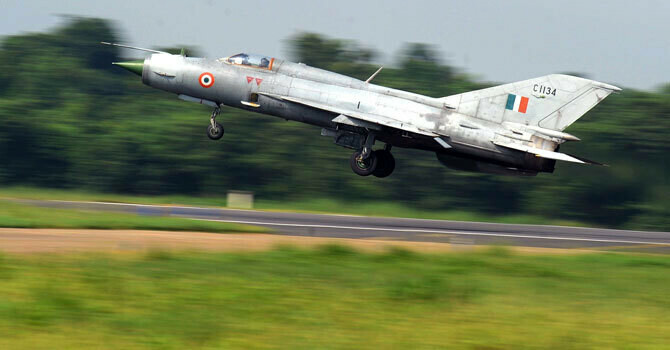NEW DELHI: The Indian Air Force (IAF) will retire its remaining fleet of Russian MiG-21s, considered the IAF’s workhorse that showed its vulnerability when Pakistan shot down one of them and captured its pilot in a Feb 2019 showdown.
According to the Indian Express, the fleet is scheduled to be retired in September after serving the IAF for six decades. Inducted in 1963, at least four MiG-21 squadrons were number-plated or retired from service between 2017 and 2024, the newspaper said, quoting unnamed sources in the military.
Its sources said the IAF is set to retire the remaining Russian-origin MiG-21 fleet in a ceremonial decommissioning at Chandigarh airbase on Sept 19.
Two squadrons of MiG-21 Bisons are currently active.
India procured more than 700 MiG-21 aircraft of different variants, such as the Type-77, Type-96, BIS and the Bison, since the aircraft’s induction in the IAF in 1963.
The phasing out of the aging MiG-21 fleet was originally scheduled to be concluded by 2022, but was held up due to a delay in the planned induction of other fighter jets, including the indigenous Light Combat Aircraft Tejas, which are set to replace the MiG-21 squadrons.
Four squadrons phased out
Between 2017 and 2024, at least four MiG-21 squadrons were phased out. India has a sanctioned fighter squadron strength of 42, but has 31 active squadrons.
The phasing out of the MiG-21 fleet will further bring down the IAF’s active fighter squadrons.
The MiG-21 Bison, which comprises the last two squadrons to be retired, is one of India’s six fighter jets.
The single engine, single-seater multi-role fighter/ground attack aircraft has been a key fighter jet with the IAF. The Bison is the latest upgrade of the MiG-21 jets.
Over 100 MiG-21s of the IAF have been upgraded to Bison over the last three decades.
The MiG-21 Bison upgrades included avionics and communication systems, electronics, multi-function display cockpits, the Kopyo light-weight multi-mode radar, radio sets, electronic warfare suite, inertial navigation system/GPS, a helmet-mounted display and a better windshield, among others. However, the engine performance and load carrying capacity of the jet could not be enhanced as part of the upgrades, with its airframe being the major limitation, the Express said.
With a maximum speed of 2,230 kilometres per hour, the jet carries one 23mm twin-barrel cannon with four R-60 close combat missiles. Initially developed as an interceptor, the supersonic jet was eventually upgraded to perform as a multi-role combat aircraft, including ground attacks.
Despite its significant role in all wars and conflicts fought by India, the MiG-21 jets had earned a mixed reputation due to several crashes, although it could have happened due to a multitude of reasons.
Some estimates say that India lost over 400 MiG-21 jets, including its variants and trainer versions, since its induction, and the crashes killed over 100 pilots and some civilians.
A MiG-21 fighter jet of the IAF crashed near Rajasthan’s Suratgarh in May 2023 while it was on a routine operational training sortie, killing three civilians. In July 2022, a MiG-21 trainer Type 69 aircraft crashed, killing Wing Commander M. Rana and Flight Lieutenant Adivitiya Bal.
Published in Dawn, July 23rd, 2025
